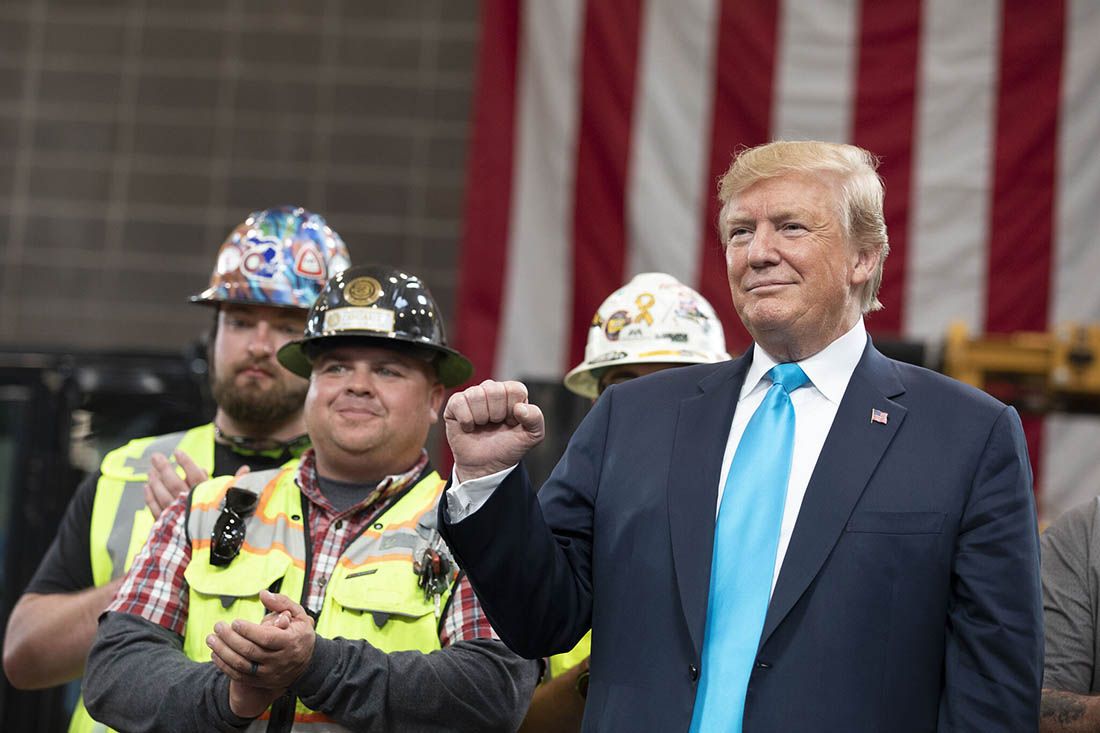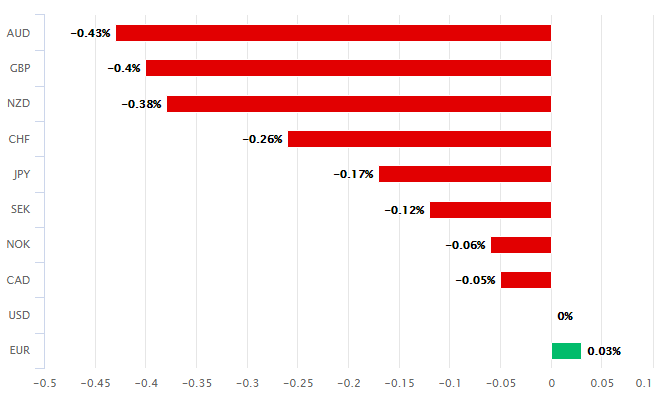Pound-Dollar Tests 1.30 after Trump Kicks Trade Deal Deadline into the Long Grass
- Written by: James Skinner

Image © White House
- USD slides as market rebuked White House trade aggression.
- Trump says U.S.-China deal may have to wait until after election.
- Comes amid Chinese response to Hong Kong and Xinjiang bills.
- And with progress toward a 'phase one' trade deal still nonexistent.
- Retaliation against French DST and over Airbus levies also rankles.
- Demonstrates Trump has appetite for tariffs despite growth slowdown.
The Dollar slumped against almost all rivals Tuesday as markets expressed disapproval of White House rhetoric on the U.S.-China trade talks and a U.S. decision to hit French exports with new tariffs, which has enabled the Pound-to-Dollar rate to again test a key resistance level on the charts.
President Donald Trump said Tuesday that a 'phase one deal' to end the trade war between the U.S. and China could be delayed until after the November 2020 Presidential election, roiling markets that had been led to believe such a thing would be finalised and formally entered into before the year is out.
Markets neglected to acknowledge a recent change for the worse in White House language on the trade talks with China,instead preferring to continue betting on an end to the tariff fight and a resulting stabilisation of the global economy. That saw them caught unawares Tuesday by comments from President Trump. whose gone from claiming that a deal has already been struck to simply stating that one is possible.
December 15 will see new tariffs imposed on all of China's remaining annual trade with the U.S. that's not yet been subjected to punitive duties unless President Trump decides otherwise. Markets had hoped the levies would be averted by a 'phase one deal' but Commerce Secretary Wilbur Ross said Monday that if an agreement is not finalised before the middle of this month then the new tariffs will be go into effect.
"FX investors appear to have reacted to ad hoc comments & actions from both sides which perhaps signaled a prolonged impasse beyond year-end. The trend in this regard seemed to start when Commerce Secretary Ross told reporters yesterday that a tariff increase was likely if the US and China did not reach a Phase 1 accord. News about tariffs on US imports from the EU and Chinese "blacklists" added to the effect," says Stephen Gallo, European head of FX strategy at BMO Capital Markets.
Trump said ahead of a NATO summit in London that he does not have a deadline for finalising the deal that he already said on October 11, was in the bag. He then said it could "better" to wait until after the November 2020 election to finalise the pact, which would mean that crushing U.S. tariffs continue to be levied on imports from China for much of the next year.

Above: U.S. Dollar performance Vs major rivals on Tuesday.
There has been speculation in recent months that China itself might like to wait until after the election before striking a deal just in case Trump fails to get re-elected. Meanwhile, investors had also speculated that electoral considerations would likely temper Trump's appetite for tariffs given they can also have an adverse impact on the countries deploying them.
Commerce Secretary Wilbur Ross reiterated in an interview with CNBC Tuesday, President Trump's earlier assertion that the December 15 tariffs will go ahead if a deal has not been finalised before then.
"The chances of a deal by Dec 15th just took another turn lower. Markets simply aren’t priced for this; for a trade deal to be that far in the future – if one can even be struck at all," says Mark Wilson, chief market analyst at Markets.com. "After weeks of making generally positive noises on a deal being very close, there is a real sense now that a deal is not so very near at all and markets need to reprice. Combined with the barrage of tariff threats on the EU, the comments can be taken as a sign that the White House has no qualms about levying further tariffs and is happy about using trade as a economic, political and diplomatic weapon."
Trump's comments came hard on the heels of a decision by the Office of the U.S. Trade Representative (USTR) recommended that tariffs of up to 100% be applied to imports of French goods worth some $2.4 bn each year in retaliation against President Emmanuel Macron's digital services tax that's due to come into force next year. The U.S. says the tax discriminates against U.S. companies, is inconsistent with international tax conventions and "unusually burdensome" for companies affected by it.
Monday's report, which concludes a 'section 301 investigation', came at the same time as the USTR said it will also look to begin the process of increasing existing tariff rates on some EU goods in response to a World Trade Organization ruling in a long-running dispute over subsidies for Airbus.
The U.S. has successfully argued that EU support for Airbus is illegal under WTO rules and that it's cost American companies revenue. It already targeted European exports of agricultural goods, airplanes and Scotch whisky in October after the WTO estimated lost revenue to be around $7.5 bn.
Above: Dollar Index shown at daily intervals.
Tuesday's trade headlines follow the influential Institute for Supply Management manufacturing PMI for November, which surprised on the downside Monday and prompted economists to suggest the recent rebound in the barometer was just a temporary phenomenon. That's also had markets looking once again at the Federal Reserve (Fed) but this time while contemplating exactly what a "material reassessment of the outlook" might actually mean in reality.
"Starting from the time the ISM Manufacturing PMI was released yesterday, there has been a squeeze on long-USD positions across the G10 space, which has been somewhat offset by renewed RMB weakness during the London morning," says BMO's Gallo. "The North American data calendar is fairly empty today. As mentioned yesterday, the ability of the USD to end the week above 1,210.00 (in BBDXY terms) hangs on geopolitical headlines, and the relative performance of US vs European economic data. Yesterday's weak ISM report from the US has clearly been a headwind for the USD."
The Fed has cut interest rates three times this year to defend the U.S. from an ongoing global economic slowdown but investor concerns about other economies have thus far prevented the Dollar from weakening in any meaningful way. However, any further rate cuts might change that and trade tensions with China and the EU could be enough to convince the Fed to pull the trigger again over the coming months.
"The US dollar has been undermined by building expectations for looser US monetary policy and liquidity conditions," says Lee Hardman, a currency analyst at MUFG. "Heavy demand for year-end funding is boosting the size of the Fed’s balance, and the additional US dollar liquidity could increase downward pressure on the US dollar once year end demand eases."
Chairman Jerome Powell has recently and repeatedly said the economy and interest rates are “in a good place” and that it'd take a “material reassessment” of the outlook to change that view. His comments were interpreted at the time as meaning another rate cut could be quite some way off. The current Federal Funds rate range is between 1.5% and 1.75%.
Above: Pound-to-Dollar rate shown at daily intervals.
"There's no doubt that the dollar is overvalued at these levels, on almost any calculation, but that's to be expected when the US economy is doing well against its peers. It's also to be expected when the President is trying to re-write trade deals with his country's biggest economic partners, to the US' advantage. But as the US economy slows, the overvaluation becomes not just more politically sensitive, but also more unsustainable. DXY is nearly 20% overvalued and the President is unhappy," says Kit Juckes, chief FX strategist at Societe Generale.
Tuesday's weakness in the greenback has now got the Pound-to-Dollar rate testing the 1.30 level resistance barrier on the charts, which has barred the British currency's path higher on repeated occasions in recent weeks. Technical analysts are Commerzbank said Tuesday the exchange rate is in an uptrend that could take it as far as 1.3187 over the coming weeks but that the British currency will struggle to get above that level.
Fundamental analysts, meanwhile, are taking their cues from changes in polls of voting intentions ahead of the December 12 general election. The Conservative Party poll lead shrank last week as support for the governing part ebbed and public enthusiasm for the opposition Labour Party was said to have increased in the wake of its manifesto launch, which saw the latter promise various 'free' public services in an effort to entice votes.
"For GBP, signs that the Tory party could be losing its advantage is a negative factor. This can largely be attributed to far-left policies of the Labour Party and related concerns about re-nationalisation and budgetary prudence," says Jane Foley, a senior strategist at Rabobank. "While it is widely hoped that the December 12 election will draw a line under political uncertainty in the UK, there is plenty of scope for this to be ongoing in the New Year. Consequently, it may be another bumpy ride for the pound."
Foley and the Rabobank team say Pound Sterling should be trading around the 1.35 level against the U.S. Dollar in 12-months time but that the exchange rate would likely fall to 1.15 in the event of a 'no deal' Brexit.
Others have made similar forecasts in regards to the December election, with many analysts looking for a Conservative victory to give the Pound-Dollar rate a shot at the 1.35 level while some look for a Labour Party victory to push Sterling all the way down to 1.15.
Currency markets favour a Conservative government. A part of the bias comes from a desire among investors to negate the threat of a 'no deal' Brexit and also see the economy move on from the current stage of negotiations, which has paralysed the Bank of England and some businesses, while the rest is centred on fears about the opposition's economic agenda.
Time to move your money? The Global Reach Best Exchange Rate Guarantee offers you competitive rates and maximises your currency transfer. Global Reach can offer great rates, tailored transfers, and market insight to help you choose the best times for you to trade. Speaking to a currency specialist helps you to capitalise on positive market shifts and make the most of your money. Find out more here.
* Advertisement







